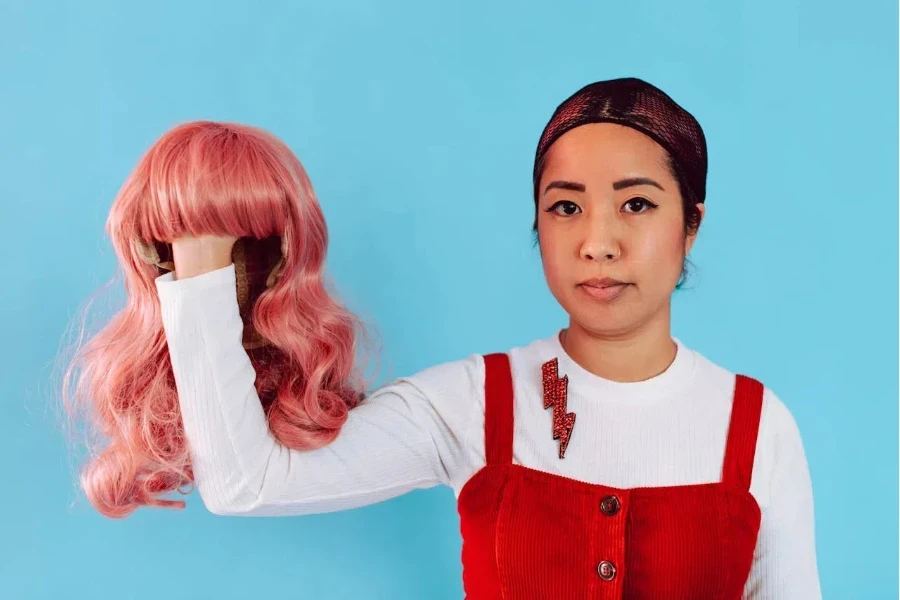Hair problems (medical and style-wise) are not new—they have been around for centuries. Wigs have also been the perfect solution, allowing people to transform their look completely with synthetic or human hair. Today, wigs have evolved so much that it requires extra focus to tell them apart from natural hair.
However, lace wigs are among the few types that have gained serious momentum today thanks to their realistic look and versatility. But what exactly is a lace wig, and how are they different from regular options? This article will break down everything businesses need to know about lace wigs.
Table of Contents
A quick look at the wig and extension market
How do lace wigs compare to regular wigs?
Lace wigs: 4 factors to look at before purchasing lace wigs
How to detect a bad lace wig
Wrapping up
A quick look at the wig and extension market
Experts predict the hair wigs and extension market will readjust to US$7.06 billion by 2028 at an impressive 10.15% compound annual growth rate (CAGR). The market is growing fast thanks to manufacturers’ continuous efforts to produce and design synthetic wigs to meet the high demand for fashionable hairstyles. With these wigs becoming more realistic with every advancement, they satisfy diverse consumer needs and preferences.
Here are other important stats to note:
- The increasing demand for synthetic and human hair shows consumers are shifting toward cosplay costumes, personal expression, and style.
- Although the offline segment is the most common way to buy wigs, the online segment is experiencing rapid growth and may soon take over.
- Experts say the Asia-Pacific will account for 46% of the growing wig and extension market over the forecast period. Countries like China, India, and Japan will contribute the most.
How do lace wigs compare to regular wigs?

Regular wigs are still popular because they are more affordable than lace wigs. The lower price makes them the go-to for many, even though they don’t offer the same level of realism. Regular wigs (human or synthetic hair) often look like hair simply placed on the user’s head.
On the other hand, manufacturers design lace wigs to look incredibly natural. They hand-tie each synthetic or human hair strand to a sheer lace base that fits over the user’s scalp, making it look like the hair is growing from a natural scalp and hairline.
Lace wigs are also attracting more attention in 2024. Google data shows that people searched for them 27,100 times on average (monthly), which increased to 33,100 times monthly in the first half of 2024 and even July and August (the first months of the second half).
Lace wigs: 4 factors to look at before purchasing lace wigs
1. Lace type

It’s easy to forget that the main part of lace wigs comes in different types. The type of lace businesses choose in a wig plays a significant role in how it looks and feels. The two most common types are Swiss and French lace.
Swiss lace is thinner and gives a more natural appearance, but it’s also more delicate and can tear easily. In contrast, French lace is thicker and more durable, making it a good choice for women new to wearing lace wigs.
Another type businesses may see from manufacturers is HD lace wigs. These options use a more transparent and thinner lace for the most natural look possible. Although HD lace wigs are popular, the lace can damage easily (depending on the manufacturer), so businesses should research before buying.
2. Human vs. synthetic hair

Another critical factor businesses must consider before picking lace wigs is hair type. Lace wigs typically use either human or synthetic hair. Human hair wigs look the most natural, allowing women to style and color like natural hair.
However, human hair lace wigs often need more upkeep, are pricier, and have all the problems of natural hair (like heat damage). On the other hand, synthetic hair lace wigs are easier to maintain and more budget-friendly—but they are not without sacrifices. Synthetic options may not have the same natural look as their human hair counterparts.
3. Wig style

Businesses must also consider the wig’s style (we’re not talking about hairstyles here). Lace wigs come in three main styles: full lace, lace front, and full lace braided wigs. Full-lace wigs come with an all-lace base, which gives women many styling possibilities and a natural-looking hairline.
Front lace wigs only have a lace front attached to traditional wig caps to give women a natural hairline. While this makes them more affordable and easier to wear, women will have limited styling options. Lastly, full-lace braided wigs combine a lace front with a braided cap to give a unique and stylish appearance.
Lace wigs can also come in closure styles. These don’t cover the hairline but have a lace patch in the middle. This protective style often comes with a 4×4 patch, but businesses can offer bigger or smaller patches depending on what customers want. Lace closure wigs don’t have many styling options, but women can dye them to enjoy a more natural scalp look.
Another less common style is the 360-lace wig. Like full-lace wigs, these have lace around the wearer’s head, but with a breathable, lightweight hair cap in the middle. This design gives women many styling options, like ponytails or side parts, while being more affordable than a full-lace wig.
4. Color

Consumers who don’t fancy dying their wigs will choose options in their favorite colors. Thankfully, lace wigs are available in various colors, from bold and vibrant shades to natural tones. However, it’s not just about offering colorful options—businesses must think about their target consumer’s skin tone and personal style.
For instance, ladies new to lace wigs may choose a shade closer to their natural hair color. But those feeling daring will not hesitate to experiment with different colors until they find the one that suits them best.
How to detect a bad lace wig
The rising popularity of lace wigs has also brought many fakes with them. People can also end up with poor-quality wigs, which can be frustrating and a waste of money. It also leaves a terrible stain on a business’s reputation. Here are four common signs to help brands avoid bad lace wigs.
1. Thick lace
One clear sign of a lousy lace wig is thickness. High-quality lace should be thin, which allows it to sit smoothly and blend well with the wearer’s skin. If the lace is thick and stiff, it will be harder for women to get a natural look, meaning the wig will stand out more.
2. Larger lace pores
Before buying a lace wig, businesses should check if the lace has large gaps between the hair strands. It’s pretty common for some braided wigs. The lace might pull if there are big spaces between the hair strands, making it harder to blend and style the wig properly. Quality wigs should have thin, evenly-spaced lace, which helps it look more natural.
3. Unusual lace color
A poor-quality lace front wig may have an unusual color instead of a natural shade. For example, wigs with brown, black, or gray lace are usually a warning sign for poor quality. A good lace wig will have a light or transparent lace, making it easier to dye and style to match the user’s scalp.
4. Poor elasticity
The quality of a lace wig depends a lot on the lace itself. The highest-quality lace wig should have enough elasticity to stretch and return to its original shape. But if the lace lacks this flexibility, it will affect the overall experience and won’t hold up well over time.
Wrapping up
Lace wigs give women a flexible and natural-looking way to change their hairstyle, deal with hair loss, or try a new look. With choices like full lace, 360 lace, and lace front, businesses can offer them the perfect one to match their style and needs.
Remember the factors discussed in this article when stocking and watch out for the typical characteristics of fake or low-quality lace wigs to create an incredible and attractive inventory for more sales in 2025.




